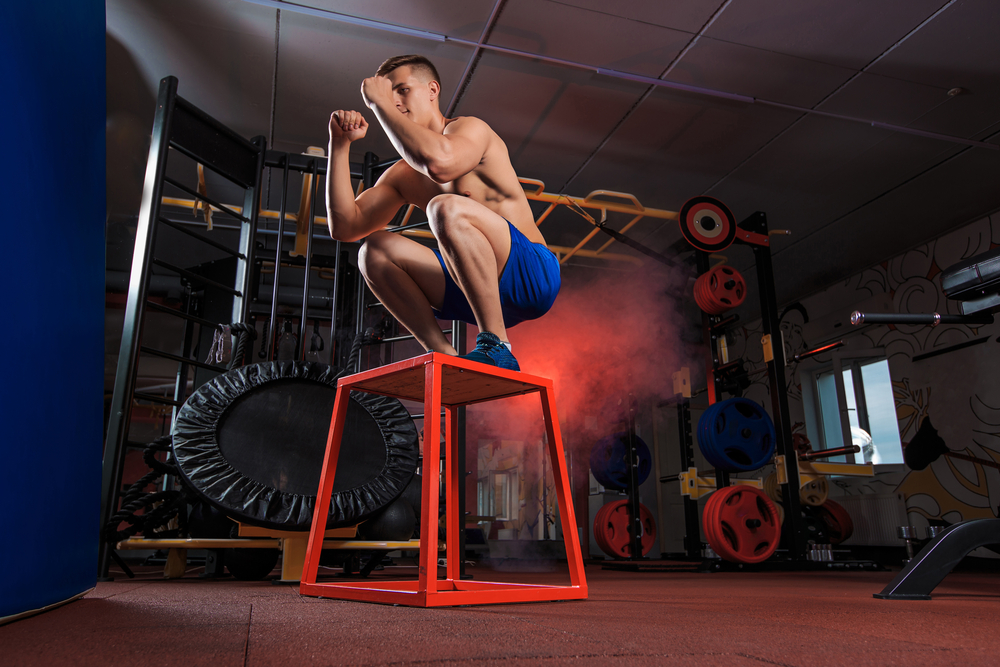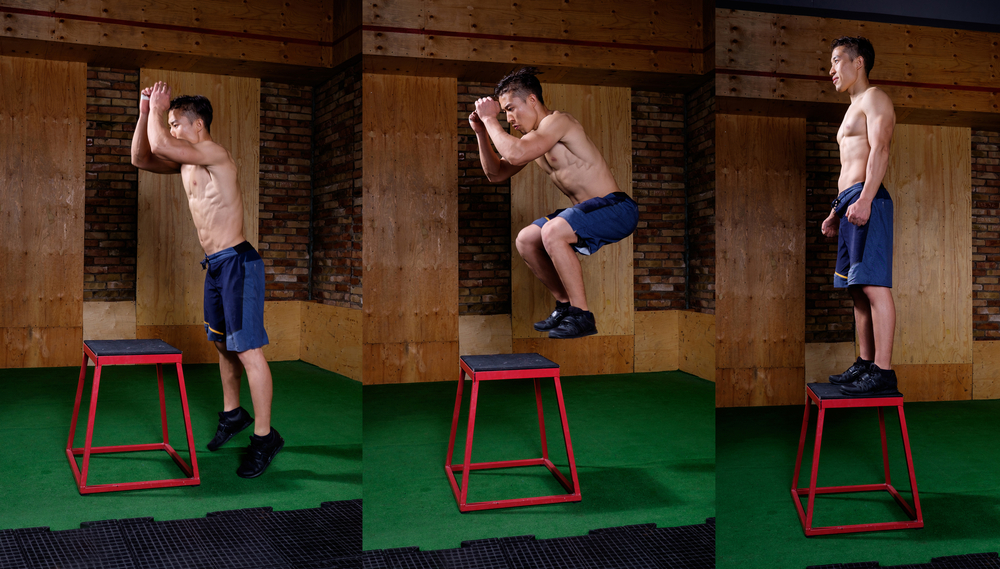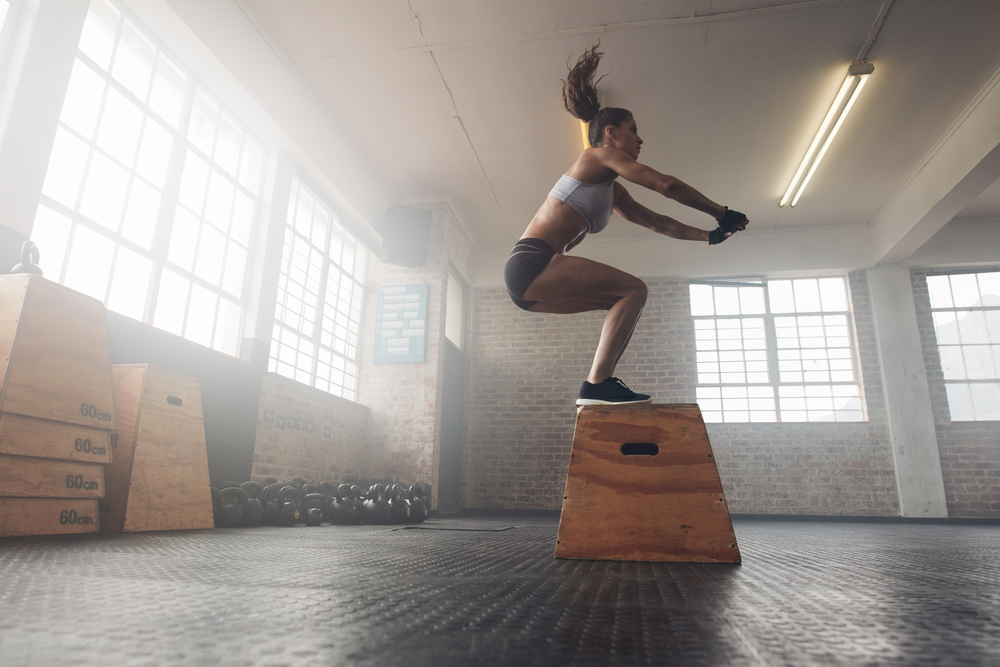[donate-btn]
You want big legs. You work your legs to gain the muscular thighs that prove you’re more than just an upper body day gym person. Today we will look into jump squats…
But how do you maximize that effort?
What kind of moves and lifts should you perform to take your normal thighs and butt to the next level?
Jump squats are some of the best lower body moves you can do. Let us show you how to bring them into your workout routine.
What is a Jump Squat?
Jump squats fall under a workout term known as plyometrics.
If you’ve ever checked out the P90X workouts or other popular exercise DVDs, you probably have come across this plyometrics term.
But what exactly does it mean?
After all, if you’re like most people you probably just accept the name and go with the flow.
The term itself means jump training.
So when you see an entire workout dedicated to plyometrics, you know every single move is going to have some sort of jumping involved. This is designed to take advantage of your bodyweight in the workout, instead of using weights (although in some instances, you can bring light weight work into the move, which is also the case with jump squats).
A jump squat is exactly what the term sounds like.
Without using weights, you lower your body into a squat position and jump. This engages your lower body in a slightly different way than a weighted squat. With a weighted squat your lower body’s may purpose is to hold up. Jumping causes your muscles to engage at a faster rate.
When the body comes back down following the jump it goes right back down into the next squat.
The Benefits of Jump Squats
You already perform regular squats on leg day, so why in the world should you even care about jump squats?
After all, you’re probably not using any weight, and if you’re going for larger, muscular legs, how is this going to help you out?
First thing is first.
The weighted squats are important for building size and mass. That isn’t going to change. You need the weight to increase size. However, there are some impressive benefits from adding jump squats into your routine.
The main reason to perform jump squats is it improves your power and explosiveness.
Have you ever seen the guy wandering through the gym, muscles upon muscles upon muscles, but he just kind of lumbers?
Yes, he might be strong, but you could run circles around him you needed.
Weighted exercises are important in building strength and increasing size. However, fast movement exercises improve quickness and your initial burst of speed. It is why plyometrics such as the jump squat is so important. This is not something the large weights you use will provide.
It’s also why you need to bring in more plyometrics into your routine as it prevents you from turning into a lumbering bunch of muscles without any athletic quickness (Livestrong, 2016).
How to Do a Jump Squat
The jump squat doesn’t take any special equipment.
Realistically you can add some very light weight (such as five-pound dumbbells in each hand, but the purpose of the move is to build power, not strength, so weights are not necessary). The great thing about this is you can perform jump squats anywhere, from the office bathroom to your home basement.
Start with your feet about shoulder width apart.
Lower yourself down so your thighs are almost parallel to the floor. You don’t need to go all the way down to 90 degrees as this will put added pressure on your knees, which can become a problem with performing an extended set of the jump squats. The entire time, keep your back straight and don’t twist away in the hips.
Everything should face forward with your spine center.
In a fluid motion, when you hit the bottom of the squat explosively jump up. When you jump, straighten your back and legs so your entire body is perfectly straight up. As you land, allow your body to move back down into a squat and repeat the process.
This is a jump squat.
Whenever performing jump squats, it is important for you to keep your butt, thighs and abdominal muscles tight. This increases the amount of resistance placed on the muscles, which helps build your explosive power from the move.
What Do I Do With My Arms?
This is a pretty common question and there are a few options.
Some people prefer to start with their arms extended out in front of them so when you are down in your squat position the legs are stretched out.
Essentially, this is designed to help provide a counter balance to your butt, which is pushed away from your legs. The arms are then pushed down towards the floor, so when you are fully elevated off the ground in your jump the arms are at your side. The arms then swing back to the parallel to the floor position when you are back in the squat position.
This move does help with balance.
However, there is a slight issue with it. The swinging of your arms creates momentum. This actually reduces the amount of lift caused by your lower body. Essentially you’re helping your lower body perform. There isn’t anything necessarily wrong with this, and if you need some help with balance this is a fine way to go.
However, there are other methods of arm placement that place all of the push on your legs, which in turn aids in the explosiveness of the move.
For the best leg gains on this move, place your hands behind your head, as if you’re going to do a crunch.
Keep your elbows pushed outward in order to open up your back. This arm position provides you with a few different benefits. First, it places your entire body weight directly above your legs. This helps add to the weight placed on your lower body. Additionally, it does not generate any kind of momentum with the move, which helps ensure all of the push comes from the lower body.
Lastly, as you are not holding your arms in front of you to help with balance, you are also strengthening the stabilizing muscles of your body as your core is forced to keep your body straight instead of the help of your arms. So, if at all possible, it is best to perform jump squats in this way, although it ultimately is up to you and your comfort level (Stack, 2017).
But I Really Want To Add Resistance To Jump Squatting
If you are bent on adding more resistance to your jump squat, there are some options.
This can help with the boost of explosiveness when you add some weight, just be careful. Because the move is done so quickly it places more pressure on your knees. The added weight resistance only increases this pressure, so if you already have knee soreness or other knee problems, it is best to avoid this all together.
In general, you have a few basic options.
First, you can go with dumbbells. If you do decide to go with dumbbells it is best to stay with something extremely light, such as 2.5 or 5-pound weights in each arm. When performing extended sets, simply adding a full 5-10 pounds can add up. Should you decide to use weights you will hold the weights up by your shoulders. Then when you jump you can either keep the weights at your shoulder or push up in a shoulder press.
Using weights can feel a bit awkward when the move is so quickly.
That is why it may be better to use body weights. Ankle weights is an easy way to increase your weight resistance without feeling awkward about it. You can also use a weighted vest. The best kinds of vests are those that allow you to remove weight. Don’t just putt on a 20-pound vest and expect for it to work out for you. Start with only a few pounds in the vest and slowly work yourself up over time.
If you don’t want to invest in a weighted vest, you can simply purchase sand bags. Holding a sandbag to the chest is a common form of resistance and it still keeps your arms close to your chest so you don’t generate false momentum with your arms. Other individuals use a kettlebell in front of their body and pull it up towards their chest when they jump. This adds a bit of a chest workout to the move.
If you are considering adding weight to your jump squats, perhaps consider using a chair or bench to jump onto.
This forces your body to jump higher than you likely would with a traditional jump squat. It also makes you catch yourself in the squat position faster, which can increase the amount of resistance placed on your thighs as you don’t have time to fully extend your legs.
It’s an option to consider if you want to increase your resistance, but always first begin with the regular jump squats before moving forward with any weights.
Muscles Worked During A Jump Squat
The jump squats affect the same muscles as a traditional squat as you are performing the same basic movement.
The only difference is how the muscles are targeted as this is a powerful, explosive move.
The primary muscles hit are the gluteus maximums and the quadriceps (gluteus and quads). The gluteus are basically the main muscles of your butt. It forms a rectangular shape, running from the side of your hip down and connects up by the tailbone. The quads make up the front muscles of your thighs. These muscles are broken down into four different regions, including the rectus femoris, the vastus lateralis, the vastus intermedius and the vastus medialis.
Each four of these parts of the quads are worked with jump squats.
The secondary muscles you work are all known as secondary muscles or stabilizers.
These muscles receive extra attention if you keep your hands on your head in the crunch position. These muscle groups include the erector spinae, the gluteus medius, hamstrings, transverse abdominous, soleus, gastrocnemius, and the adductors.
Jump Squat Workout Routine
This is not a move you do to exhaustion.
If you’re looking for massive muscle gains and want to include jump squats, you can use the weighted vest. Instead, if you’re going for maximum performance, you can set it as a timing move. Perform as many jump squats as you can over 30 seconds and repeat the process later in your leg workout. Then attempt to beat the time on your next leg day. Just make sure you keep the same posture and same explosive force. The main purpose behind training like this is to reduce any kind of rest time in between jump squats.
When first adding the move to your custom workout routine, perform 20 reps in a set and perform this three different times.
If by the end of your third set you don’t feel tired or don’t struggle to hit 20, bump it up to 25 or 30.
This may also be a good time to move towards the timed set as the less wait and recovery time you have between jump squats the more difficult the move becomes.
When Should I Stop?
Don’t perform this move if you have any kind of knee pain. If you begin to feel tightness or soreness in your knee you know is not from a muscle, you need to stop the move and consult your doctor sooner rather than later.
Conclusion
With the help of jump squats, you’ll instantly feel the move in your legs. The added push of a jump takes your lower body workout to new heights as you maximize your workout. After all, it’s not how long you train, it’s how hard.
So on your next leg day, make sure to put the jump squat into your workout.
-Terry Asher
Terry Asher
Latest posts by Terry Asher (see all)
- Better Family – Product Review Liquid Daily 2 oz - Dec 16, 2024
- Post-Workout Recovery: The Key to Optimal Performance - Nov 25, 2024
- Pre-Workout Supplements – Everything You Need To Know - Nov 18, 2024














[…] post Jump squats – How To Perform Them appeared first on Gym […]
[…] post Jump squats – How To Perform Them appeared first on Gym […]
[…] Jumps are nice and helpful in your core and legs, there isn’t any doubt, however once more it’s about correct kind, if you don’t soar correctly you can be placing your knees below loads of pressure. Everytime you soar you must land in your toes and never in your heels. If you happen to achieve this you’ll put pointless pressure in your knees and the knees would possibly get infected. If you happen to land in your heels you additionally threat the possibilities of heel accidents too. Your calf muscles may also tear and also you would possibly want loads of time for it to heal. Your hamstring may also get pulled and you can be in agony. However when you soar slowly and land in your toes like a cat you’ll not get an damage. In reality, whenever you soar your coach will all the time let you know to land like a cat, you need to hold that in thoughts to avoid accidents. […]
[…] Jumps are great and beneficial for your core and legs, there is no doubt, but again it is about proper form, if you do not jump properly you will be putting your knees under a lot of strain. Whenever you jump you need to land on your toes and not on your heels. If you do so you will put unnecessary strain on your knees and the knees might get inflamed. If you land on your heels you also risk the chances of heel injuries too. Your calf muscles can also tear and you might need a lot of time for it to heal. Your hamstring can also get pulled and you will be in agony. But if you jump slowly and land on your feet like a cat you will not get an injury. In fact, when you jump your trainer will always tell you to land like a cat, you should keep that in mind to stay away from injuries. […]